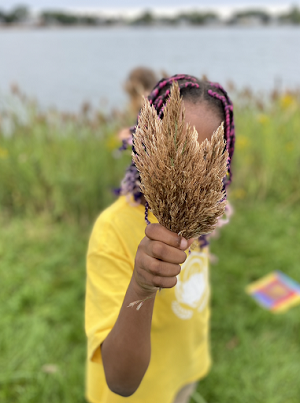Reflections of an Outdoor Educator

eeBLUE: Watershed Chronicles
This post was written by Emily Flaherty, School to Sea Director of Salem Sound Coastwatch.
As an outdoor educator, I always have lofty goals in mind for our programming: every child will have a deep understanding of and want to protect the watershed; they will have fun and want to do our activities; they will hang on our every word and ask poignant questions at just the right moments. I also have lofty goals of my own built up by all of my life and work experiences: I want to protect and enhance our natural resources; I want to reduce the amount of bacteria making it to our embayment so that we can finally re-open the shellfish beds that have been closed for decades. But my students don’t have the same life experiences to build on. They see or explore only what is in front of them, potentially unaware of the extent of human’s impact on our environment. When they start to piece it together, how do we balance sharing the simple wonders of the world with the urgent need to protect our planet?
I think it comes down to sneaky learning—the observational kind, when you learn through experiences, tying moments together to make your own conclusions.
What are the children concluding? Is it what we intend? Who knows what they go home and tell their family. Maybe it’s two weeks later and they share a fact at the dinner table. Maybe the fact is completely backwards and not what was said, but it is what they heard in between chattering excitement and blurted non-sequiturs from their peers.
Did they hear, “phragmites is invasive and that’s why we are cutting it?” Or did they hear, “this is a flower, let's cut it?” How do we evaluate this? How do we know that each of these students, who all learn in different ways, understands why we are doing this? What does it have to do with the watershed? Will they walk away with a misconception and share it with others? Maybe.
Three weeks later, we come in for a new program; a fresh start with a different mix of students. From across the busy cafeteria, we hear: “Hey, you’re the ones we cut down the phragmites with—that invasive plant that was pushing in on the living shoreline!” What?! Seriously, Fernando—you rock!
We’ve built relationships and, even though I struggle to remember their names,
I recognize their faces and they recognize mine. We’ve started to become a part of the culture of the school. It’s become about more than making sure they have a deep understanding of the watershed. It’s about building their experiences and connections, opening the door to become stewards of their place.

This piecing together looks messy in informal education. In afterschool programming, it takes flexibility, patience, positivity, and a bottomless toolkit. Here are two of my most recent toolkit additions:
“Caption This” – Students use this literary tool to write captions for pictures of them participating in previous activities.
It hits three objectives: 1. It’s reflective and puts them back in the moment with a view of themselves outdoors; 2. They work on sentence structure, spelling, and punctuation; 3. They visually and reflectively piece together the activities that we plan in sequence, building their understanding of the watershed.
SNACKS – They’re hangry after school and we all know there is no reasoning with a hangry child. When we started bringing our own snacks it was like someone turned on the lights and they could see clearly.
We continue to build our toolboxes and adjust, staying relevant to students and creative in our delivery, persisting to bring positive outdoor experiences to students. Sharing ideas and collaborating with others only makes this growth stronger.
The NOAA Office of Education and NAAEE partnered to increase environmental and science literacy among NOAA’s partners and external networks. In this five-year partnership supported by the U.S. Department of Education, NOAA and NAAEE worked together to provide enriching after-school watershed-related STEM (science, technology, engineering, and mathematics) projects through NOAA-21st Century Community Learning Centers Watershed STEM Education Partnership grants. These grants supported programming for a total of 100 local 21st Century Community Learning Centers (21st CCLC) sites and their students. The 30 selected projects served 18 states, ranging from Alaska to Florida.


